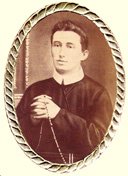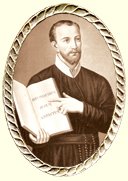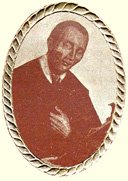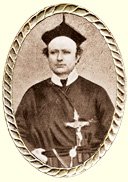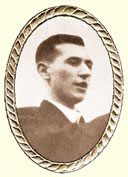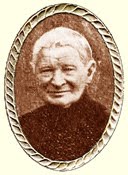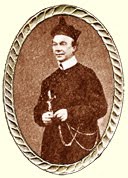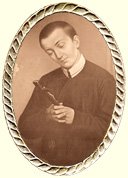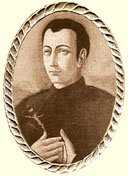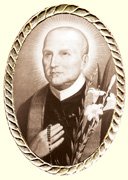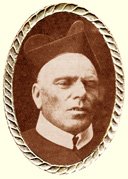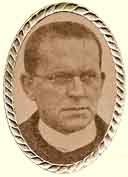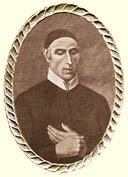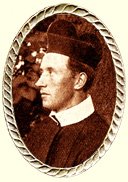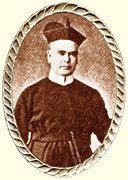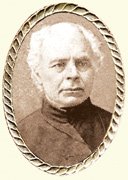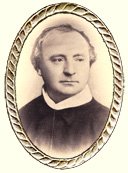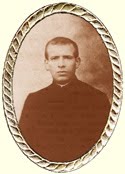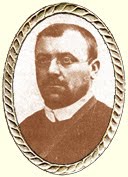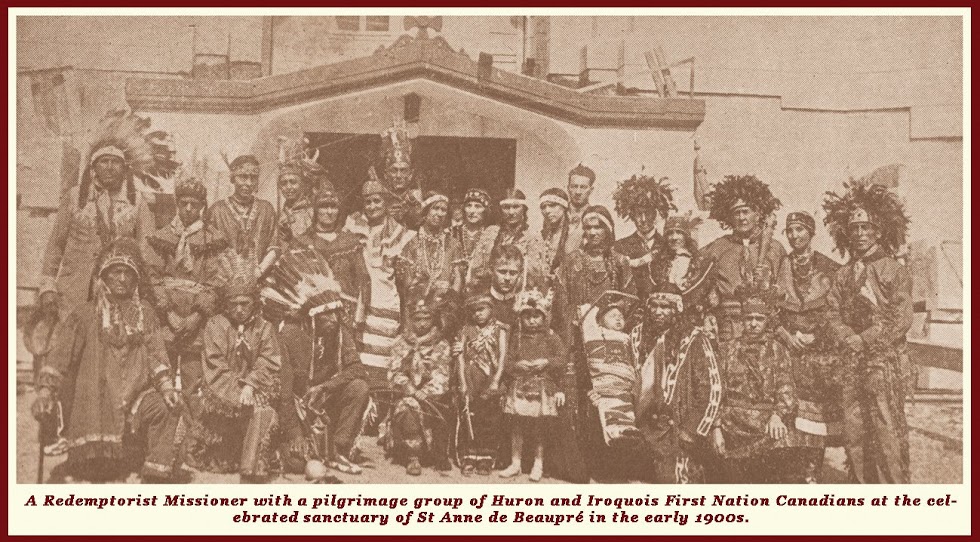The Servant of God Br Rosario La Duca, C.SS.R (1793-1860)
Brother Rosario La Duca was born on the 6th of October, 1793 in Maschito, Potenza, the son of Carmine and Mario Cappariello. At the age of 14 he lost his father and, coming from a large, impoverished family, was obliged to start work as a shepherd.
From then on he would spend all day in prayer and to this purpose he carried small devotional images and some candles. He would erect little altars and, like St Paschal Baylon, he would pray continuously while the flock was grazing. He had a special devotion to the rosary. At the age of 20, in 1813, he bade farewell to his parents and the world so as to join the Redemptorist Order. He spent his noviciate in Illiceto with the fervour one would expect of a saint.
Here he accustomed himself to the physical mortifications which he was to practise until the end of his life: every morning he got up at 5 o’clock, often wore a hair shirt, and scourged himself at least twice a week; on Wednesdays, Fridays and Saturdays he made the Stations of the Cross before lunch and dinner; he kissed his fellow brothers’ feet to beg for soup; blended herbs for his main courses and ate kneeling or else seated on the ground in a slightly uncomfortable position. He often spent long hours on his knees without a break. And in addition to all these he carried out the daily and weekly hardships allotted to the novices.
He visited Jesus in the most Holy Sacrament of the Altar very frequently and received Him every day at Holy Communion. Each morning he asked Our Lady for her blessing and before putting on his cloak he would recite three 3 Hail Marys, prostrating himself and adding to each the beautiful ejaculation, “By thy Immaculate Conception, O Mary, make my body pure and my soul holy.”
He recited the Hail Mary many times throughout the day, especially at the beginning and end of different undertakings. He often prayed the Holy Rosary and happily carried the beads by his side, keeping them in his hands continuously when not occupied by work. Day after day he asked Our Lady for the grace of Holy Perseverance in the Institute whilst praying the Salve Regina.
He entertained a special devotion to Our Lady, Mediatrix of all Graces, who was venerated in his own village and of whom he had a picture in his cell. He also venerated Mary Most Holy using the titles Our Lady of Sorrows and The Immaculate Conception, and during the day would utter several times the affectionate prayer of St Alphonsus that begins,“Most Holy and Immaculate Virgin, and my Mother Mary”.
Like all Redemptorists of the day he wished to take the so-called “vow of blood.” This meant that he would be ready to shed his own blood if necessary, in order to defend the honour afforded to Mary by her Conception without stain of sin. This honour was defined by Blessed Pius IX as an article of faith on the 8th of September, 1854, and the news was received with an exceedingly joyful heart by Brother Rosario.
On every Wednesday and Saturday of the year he abstained from eating meat, as is usual on Fridays. On Saturdays, in imitation of St Alphonsus and St Gerard, the fast consisted mostly of bread and water and he also used to practice this mortification on the vigils of the principal feasts of the Blessed Virgin Mary. In the novena days that preceded such feast days, Br Rosario also adhered to the special mortifications and corporal penances of the Congregation.
At the end of his noviciate, he moved to the monastery of Pagani and from there he was allotted to that of Girgenti, Sicily.
In 1826 the Rector Major, Fr Cocle, moved to the Monastery of Girgenti and sought Br Rosario’s assistance in the library. What greater praise could testify to the virtue of our brother than the of faith placed in him by his superiors and especially by the illustrious Rector Major.
On the 8th of September, 1827, the feast of the Nativity of the Blessed Virgin Mary, he committed himself completely to God with the sacred vows of poverty, chastity and obedience, to which was added the vow of perseverance in the Institute.
He was entrusted with taking care of the monastery church and was thus engaged practically the entire day. He was constantly going back and forth, keeping it clean and putting everything in its place. So swift was he in discharging his chores as sacristan, that it seemed as though his feet were gliding above the ground.
Having organised everything, instead of taking a rest he would kneel down to pray. The faithful admired this and approaching him they would recommend themselves to his fervent prayers. He would reply with his habitual expression, “God’s will be done.”
The inauspicious decree of Garibaldi in 1860 was directed also against the Redemptorists, obliging them to dissolve before the 2nd of August. But where were they to go? Their love for the Congregation wouldn’t allow them to be separated from it, and therefore the decision was made to seek asylum on the island of Malta; but Brother Rosarius, because he was 67 years old and in poor health, stayed on in Sicily as custodian of the precious church built in 1858 in honour of St Alphonsus. In this way he was able to continue to show examples of prayer and penance as sacristan, a position he had previously held for many years to the great edification of the faithful.
After falling gravely ill, Alphonsus Manto (father of Paulo Manto who later identified Brother Rosarius’ grave) lovingly attributed his recovery to Brother Rosarius. The brother gave Alphonsus a pair of his poor, worn breeches saying, “Take these for your wife, Alphonsus, for they will be useful for your children.” They were indeed used by that pious family and still are as the breeches are passed from house to house to ward off various diseases.
On 19 August, 1860, on the Sunday before the Octave of the Assumption of the Blessed Virgin Mary, Rosarius said to his friend: “Go outside, Alphonsus, and leave me on my own.” As Alphonsus was honouring this request, he saw with amazement from the doorway Rosarius sitting on a bed with his face lit up as if in ecstasy in contemplation of the lovely statue of the Blessed Virgin Mary, Mother of Graces. (This statue stands today in the church by the altar of St Michael.) Later, Alphonsus went into the little bedroom and found the brother looking as if he were on the point of expiring and offering no replies to his questions. So Alphonsus recited the litanies for the commendation of the soul, and when he had finished, at 5am, Rosarius gave up his soul.
No sooner had the news of his death emerged when a stream of people came to see his body or touch it, and many objects in the room were apropriated as precious relics. The general consensus being that Br Rosario was a saintly man, gave rise to the idea of conserving his features by reproducing his visage on canvas. Beneath the image, D. Giov. B. Picone wrote the following words, summarising his entire life:
“Frater Rosarius Adduca laicus professus C. SS. R. lucanus, Charitate erga deum et pauperes fervens, sine intermissione per multos annos orans, durissimo vitae genere carnem spiritui subijciens, regularis observantiae exemplum. Animam Deo reddidit 19 Augusti 1860.”
A few days previously Brother Rosarius had said to Alphonsus: “You are to bury me before the altar of the Sorrowful Virgin.” However, permission was necessary from the dreadful authorities; and since there was no hope of this request being acceded to, his friends secretly took the body in the dead of night and buried it in the sacred place Rosarius had desired. Before the burial, Alfonsus had been to take his measurements for the coffin. Whilst about it, Br Rosario opened his eyes and looked at him for a while with a satisfied smile, a sign of gratitude for what Sig. Manto was doing for him.
The register of deaths in the public archives of Rome records it thus:
“Rosarius Adduca, laicus, obiit in Girgenti die 19 Aug. 1860, aetate provectus et jam morte vicinus cum Nostri insulam dereliquerunt.”
Upon returning to Girgenti in 1914, the Fathers found a statue of a Redemptorist in the sacristy of the Church of St Alphonsus. Beneath the statue they discovered the following inscription:
From then on he would spend all day in prayer and to this purpose he carried small devotional images and some candles. He would erect little altars and, like St Paschal Baylon, he would pray continuously while the flock was grazing. He had a special devotion to the rosary. At the age of 20, in 1813, he bade farewell to his parents and the world so as to join the Redemptorist Order. He spent his noviciate in Illiceto with the fervour one would expect of a saint.
Here he accustomed himself to the physical mortifications which he was to practise until the end of his life: every morning he got up at 5 o’clock, often wore a hair shirt, and scourged himself at least twice a week; on Wednesdays, Fridays and Saturdays he made the Stations of the Cross before lunch and dinner; he kissed his fellow brothers’ feet to beg for soup; blended herbs for his main courses and ate kneeling or else seated on the ground in a slightly uncomfortable position. He often spent long hours on his knees without a break. And in addition to all these he carried out the daily and weekly hardships allotted to the novices.
He visited Jesus in the most Holy Sacrament of the Altar very frequently and received Him every day at Holy Communion. Each morning he asked Our Lady for her blessing and before putting on his cloak he would recite three 3 Hail Marys, prostrating himself and adding to each the beautiful ejaculation, “By thy Immaculate Conception, O Mary, make my body pure and my soul holy.”
He recited the Hail Mary many times throughout the day, especially at the beginning and end of different undertakings. He often prayed the Holy Rosary and happily carried the beads by his side, keeping them in his hands continuously when not occupied by work. Day after day he asked Our Lady for the grace of Holy Perseverance in the Institute whilst praying the Salve Regina.
He entertained a special devotion to Our Lady, Mediatrix of all Graces, who was venerated in his own village and of whom he had a picture in his cell. He also venerated Mary Most Holy using the titles Our Lady of Sorrows and The Immaculate Conception, and during the day would utter several times the affectionate prayer of St Alphonsus that begins,“Most Holy and Immaculate Virgin, and my Mother Mary”.
Like all Redemptorists of the day he wished to take the so-called “vow of blood.” This meant that he would be ready to shed his own blood if necessary, in order to defend the honour afforded to Mary by her Conception without stain of sin. This honour was defined by Blessed Pius IX as an article of faith on the 8th of September, 1854, and the news was received with an exceedingly joyful heart by Brother Rosario.
On every Wednesday and Saturday of the year he abstained from eating meat, as is usual on Fridays. On Saturdays, in imitation of St Alphonsus and St Gerard, the fast consisted mostly of bread and water and he also used to practice this mortification on the vigils of the principal feasts of the Blessed Virgin Mary. In the novena days that preceded such feast days, Br Rosario also adhered to the special mortifications and corporal penances of the Congregation.
At the end of his noviciate, he moved to the monastery of Pagani and from there he was allotted to that of Girgenti, Sicily.
In 1826 the Rector Major, Fr Cocle, moved to the Monastery of Girgenti and sought Br Rosario’s assistance in the library. What greater praise could testify to the virtue of our brother than the of faith placed in him by his superiors and especially by the illustrious Rector Major.
On the 8th of September, 1827, the feast of the Nativity of the Blessed Virgin Mary, he committed himself completely to God with the sacred vows of poverty, chastity and obedience, to which was added the vow of perseverance in the Institute.
He was entrusted with taking care of the monastery church and was thus engaged practically the entire day. He was constantly going back and forth, keeping it clean and putting everything in its place. So swift was he in discharging his chores as sacristan, that it seemed as though his feet were gliding above the ground.
Having organised everything, instead of taking a rest he would kneel down to pray. The faithful admired this and approaching him they would recommend themselves to his fervent prayers. He would reply with his habitual expression, “God’s will be done.”
The inauspicious decree of Garibaldi in 1860 was directed also against the Redemptorists, obliging them to dissolve before the 2nd of August. But where were they to go? Their love for the Congregation wouldn’t allow them to be separated from it, and therefore the decision was made to seek asylum on the island of Malta; but Brother Rosarius, because he was 67 years old and in poor health, stayed on in Sicily as custodian of the precious church built in 1858 in honour of St Alphonsus. In this way he was able to continue to show examples of prayer and penance as sacristan, a position he had previously held for many years to the great edification of the faithful.
After falling gravely ill, Alphonsus Manto (father of Paulo Manto who later identified Brother Rosarius’ grave) lovingly attributed his recovery to Brother Rosarius. The brother gave Alphonsus a pair of his poor, worn breeches saying, “Take these for your wife, Alphonsus, for they will be useful for your children.” They were indeed used by that pious family and still are as the breeches are passed from house to house to ward off various diseases.
On 19 August, 1860, on the Sunday before the Octave of the Assumption of the Blessed Virgin Mary, Rosarius said to his friend: “Go outside, Alphonsus, and leave me on my own.” As Alphonsus was honouring this request, he saw with amazement from the doorway Rosarius sitting on a bed with his face lit up as if in ecstasy in contemplation of the lovely statue of the Blessed Virgin Mary, Mother of Graces. (This statue stands today in the church by the altar of St Michael.) Later, Alphonsus went into the little bedroom and found the brother looking as if he were on the point of expiring and offering no replies to his questions. So Alphonsus recited the litanies for the commendation of the soul, and when he had finished, at 5am, Rosarius gave up his soul.
No sooner had the news of his death emerged when a stream of people came to see his body or touch it, and many objects in the room were apropriated as precious relics. The general consensus being that Br Rosario was a saintly man, gave rise to the idea of conserving his features by reproducing his visage on canvas. Beneath the image, D. Giov. B. Picone wrote the following words, summarising his entire life:
“Frater Rosarius Adduca laicus professus C. SS. R. lucanus, Charitate erga deum et pauperes fervens, sine intermissione per multos annos orans, durissimo vitae genere carnem spiritui subijciens, regularis observantiae exemplum. Animam Deo reddidit 19 Augusti 1860.”
A few days previously Brother Rosarius had said to Alphonsus: “You are to bury me before the altar of the Sorrowful Virgin.” However, permission was necessary from the dreadful authorities; and since there was no hope of this request being acceded to, his friends secretly took the body in the dead of night and buried it in the sacred place Rosarius had desired. Before the burial, Alfonsus had been to take his measurements for the coffin. Whilst about it, Br Rosario opened his eyes and looked at him for a while with a satisfied smile, a sign of gratitude for what Sig. Manto was doing for him.
The register of deaths in the public archives of Rome records it thus:
“Rosarius Adduca, laicus, obiit in Girgenti die 19 Aug. 1860, aetate provectus et jam morte vicinus cum Nostri insulam dereliquerunt.”
Upon returning to Girgenti in 1914, the Fathers found a statue of a Redemptorist in the sacristy of the Church of St Alphonsus. Beneath the statue they discovered the following inscription:
Brother Rosarius La Duca, professed lay brother of the Congregation of the Most Holy Redeemer.
Burning with love for God and for the poor, praying without ceasing for many years, subjecting the flesh to the spirit by a very harsh regimen of life, an example of regular observation of the Rule. He returned his soul to God on August 19th on the feast day of God’s servant, Alphonsus di Liguori.
Burning with love for God and for the poor, praying without ceasing for many years, subjecting the flesh to the spirit by a very harsh regimen of life, an example of regular observation of the Rule. He returned his soul to God on August 19th on the feast day of God’s servant, Alphonsus di Liguori.
Brief but memorable, the encomium reveals that by 1860 the feast of St Alphonsus had been translated to 19 August. Inscribed on the bottom of the tablet, apart from the date of his death, are the names of all those who had contributed to the carving on the statue by Onophrius of Zinafra.
In the previous year, when the Rector of the Monastery of Girgenti and the Superior of the Province of Sicily–Calabria, Rev. Fr Aloysius M. Nobili, began work to renovate the floor of the sacred building, a pious widow from Mamum, Paula Manto, pointed out a particular spot in the church and said: “Here is where the body of the holy religious Brother Rosarius was buried.” She spoke the truth, for on 13 September, 1929, the tomb was discovered on the left hand side in front of the High Altar.
It is easy to understand why the memory of this brother is imprinted on the minds of the local people. Although very few who had known Brother Rosarius were still alive in 1929 when his tomb was discovered, the renown of his outstanding virtues had been personally passed on to later generations through various anecdotes told and retold over the years. Written documentation, apart from the inscription mentioned above, has not come to light.
Ever since his tomb was found, the faithful began to pray for this brother’s intercession with God, and many claim that their prayers were answered in marvelous ways. The remains of Br Rosarius, a few bones and ashes, were respectfully reburied in a funerary casket by the brethren in their original resting-place. Moreover, the Administrator, Rev. Fr Joseph de Caro made public a collection of stories about the dead man. In the small biography of Brother Rosario, written by P. de Caro, there are reports of many graces obtained from God at his intercession.
 Of graces attributed to the intercession of Brother Rosarius we record this instance. On 15 September, 1929, in the year of the discovery of his tomb, Julietta Guaia, who had suffered so badly for nine long years from arthritis that she could not move at all, was fully restored to health in the presence of a large crowd at the tomb of the humble brother. What is particularly extraordinary about the event is that this girl had accurately dreamed during the night of 26 May (before the discovery of Rosarius’ tomb), that she would be cured in that place. She had told the content of her dream straightaway early the next day to four women friends. When she was taken to the church on that 15 September, she was at once able to predict with total accuracy where Brother Rosarius’ body lay. May it please the Most High that this faithful servant of His, whose life was hidden with Christ in God, be glorified before the whole world.
Of graces attributed to the intercession of Brother Rosarius we record this instance. On 15 September, 1929, in the year of the discovery of his tomb, Julietta Guaia, who had suffered so badly for nine long years from arthritis that she could not move at all, was fully restored to health in the presence of a large crowd at the tomb of the humble brother. What is particularly extraordinary about the event is that this girl had accurately dreamed during the night of 26 May (before the discovery of Rosarius’ tomb), that she would be cured in that place. She had told the content of her dream straightaway early the next day to four women friends. When she was taken to the church on that 15 September, she was at once able to predict with total accuracy where Brother Rosarius’ body lay. May it please the Most High that this faithful servant of His, whose life was hidden with Christ in God, be glorified before the whole world.(Translated from Latin by Mr Philip Lane of Tasmania.)





















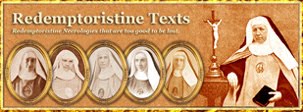
.jpg)









